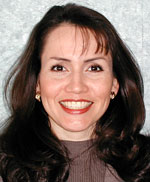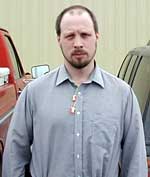Hispanic Population Changes the Face of Rural Minnesota
By Tim Post, Minnesota Public Radio
March 30, 2001
Part of MPR's online coverage of The Faces of Minnesota
Census 2000 figures released this week show a huge jump in the state's Hispanic population, the fastest-growing minority population in the state. Statewide, in 1990 there were 53,884 people claiming Hispanic heritage. In 2000 that number is 143,382. Minnesota's Hispanic population showed significant increases across the state - not just in urban areas, but in the state's smaller towns as well. Much of that growth has come in a few west central Minnesota communities where industry has attracted large numbers of workers from Mexico. Towns, like Long Prairie in Todd County, are adjusting to a more diverse population. But the adjustment will be a long and difficult process.
THE HISPANIC POPULATION IN TODD COUNTY HAS EXPLODED
in the last decade. Gloria Edin doesn't need census figures to tell her that. Edin is Todd County's Hispanic liaison, a position created 18 months ago to serve the area's growing Spanish-speaking population. Over the last year, Edin's workload has tripled - then quadrupled.
"They come to me for financial reasons, housing needs, health care needs, help with the court system, help with reading mail, immigration needs, everything imaginable. It's just amazing."
Most of Edin's day is spent translating. Translating for a landlord, a car dealer, or at the local clinic. This morning, Edin leaves her downtown Long Prairie office, Spanish law dictionary in hand, and heads a block south to the Todd County courthouse. Edin sits down with a young man, and explains the charges he's about to face in the courtroom, for driving without a license or proof of insurance.
Todd County pays Edin for 25 hours of work per week, but she actually works 50 hours per week. She keeps up the dizzying pace because, she says, she's an unconditional advocate for a group of people that many in the community haven't welcomed.
"There are people in the community that don't like the Mexicans here, and that's for real," says Edin. "There are people that call me and say that the Mexicans are dirty people, they are here to overpopulate our country. They say some really horrible things, and that is what keeps me going."
Edin applauds Todd County for funding a Hispanic liaison office, but feels there is a need for more liaisons in Long Prairie. She would like to see several people hired to help in the courts, at the hospital, at the school and in local businesses. Edin says an even more difficult proposition at this point is to get the community to accept its increasing diversity.
For most of it's history, the town of Long Prairie has been overwhelmingly white. Now, close to one-third of its population is Hispanic, quite a change for a town of about 3000 people.
Long Prairie Mayor Don Rasmussen says his city's complexion started to change about five or six years ago. Rasmussen says many in the community fear change, and that's made the transition to a more diverse population difficult for everyone. Rasmussen who was elected mayor last fall, welcomes change, and takes time to try to convince others to accept the city's new residents.
"The first thing I say when somebody questions, I say, 'How many people have you gone out and met? How many people do you say "hi" to when you're walking down the street? And how much have you attempted to understand other people - before you criticize,'" Rasmussen says.
And although Rasmussen admits the city hasn't done its best preparing for the changing population, he says things are getting better. For instance, more churches are getting involved and lending a helping hand to the Hispanic community.
Even some of the employers in town are challenging long-held prejudices. Daybreak Foods, on the north side of Long Prairie, produces 1.5 million gallons of liquid egg product a week. That's the "stuff" used by other companies to make their products. About half of the 40 workers at the plant are Hispanic. Plant manager Steve Mesia says the company hasn't always had a positive relationship with its Hispanic workforce. Mesia says he was hired in part to improve things. And over time, that improvement will make its way to the community.
"I think some of the direct prejudices have been replaced by those that are much lower-key, and I don't know how long it takes to get past it. I think that's a generational thing. It's going to take the falling-off of a generation or two, to make that go away," says Mesia.
While the 2000 census numbers show a booming Hispanic population in Minnesota, it may not have counted everyone. Under-reporting is a big problem in determining how many Hispanic residents Todd County has. The census reports 405 Hispanic residents in the county. But Mayor Don Rasmussen thinks their are at least 800 Hispanic people in Long Prairie itself. Todd County's Hispanic liaison, Gloria Edin, estimates that number at closer to 1,000. She says the majority of the population is here illegally, and that makes some Latinos wary of a government effort to count them. Edin hopes the latest census figures, even if they are not completely accurate, will convince local, state and federal officials that Minnesota's rural Hispanic population deserves support.
By Tim Post, Minnesota Public Radio
March 30, 2001
Part of MPR's online coverage of The Faces of Minnesota
|
|
RealAudio |
Census 2000 figures released this week show a huge jump in the state's Hispanic population, the fastest-growing minority population in the state. Statewide, in 1990 there were 53,884 people claiming Hispanic heritage. In 2000 that number is 143,382. Minnesota's Hispanic population showed significant increases across the state - not just in urban areas, but in the state's smaller towns as well. Much of that growth has come in a few west central Minnesota communities where industry has attracted large numbers of workers from Mexico. Towns, like Long Prairie in Todd County, are adjusting to a more diverse population. But the adjustment will be a long and difficult process.
| |
|
|
|
||
"They come to me for financial reasons, housing needs, health care needs, help with the court system, help with reading mail, immigration needs, everything imaginable. It's just amazing."
Most of Edin's day is spent translating. Translating for a landlord, a car dealer, or at the local clinic. This morning, Edin leaves her downtown Long Prairie office, Spanish law dictionary in hand, and heads a block south to the Todd County courthouse. Edin sits down with a young man, and explains the charges he's about to face in the courtroom, for driving without a license or proof of insurance.
Todd County pays Edin for 25 hours of work per week, but she actually works 50 hours per week. She keeps up the dizzying pace because, she says, she's an unconditional advocate for a group of people that many in the community haven't welcomed.
"There are people in the community that don't like the Mexicans here, and that's for real," says Edin. "There are people that call me and say that the Mexicans are dirty people, they are here to overpopulate our country. They say some really horrible things, and that is what keeps me going."
Edin applauds Todd County for funding a Hispanic liaison office, but feels there is a need for more liaisons in Long Prairie. She would like to see several people hired to help in the courts, at the hospital, at the school and in local businesses. Edin says an even more difficult proposition at this point is to get the community to accept its increasing diversity.
For most of it's history, the town of Long Prairie has been overwhelmingly white. Now, close to one-third of its population is Hispanic, quite a change for a town of about 3000 people.
Long Prairie Mayor Don Rasmussen says his city's complexion started to change about five or six years ago. Rasmussen says many in the community fear change, and that's made the transition to a more diverse population difficult for everyone. Rasmussen who was elected mayor last fall, welcomes change, and takes time to try to convince others to accept the city's new residents.
"The first thing I say when somebody questions, I say, 'How many people have you gone out and met? How many people do you say "hi" to when you're walking down the street? And how much have you attempted to understand other people - before you criticize,'" Rasmussen says.
| |
|
|
|
||
Even some of the employers in town are challenging long-held prejudices. Daybreak Foods, on the north side of Long Prairie, produces 1.5 million gallons of liquid egg product a week. That's the "stuff" used by other companies to make their products. About half of the 40 workers at the plant are Hispanic. Plant manager Steve Mesia says the company hasn't always had a positive relationship with its Hispanic workforce. Mesia says he was hired in part to improve things. And over time, that improvement will make its way to the community.
"I think some of the direct prejudices have been replaced by those that are much lower-key, and I don't know how long it takes to get past it. I think that's a generational thing. It's going to take the falling-off of a generation or two, to make that go away," says Mesia.
While the 2000 census numbers show a booming Hispanic population in Minnesota, it may not have counted everyone. Under-reporting is a big problem in determining how many Hispanic residents Todd County has. The census reports 405 Hispanic residents in the county. But Mayor Don Rasmussen thinks their are at least 800 Hispanic people in Long Prairie itself. Todd County's Hispanic liaison, Gloria Edin, estimates that number at closer to 1,000. She says the majority of the population is here illegally, and that makes some Latinos wary of a government effort to count them. Edin hopes the latest census figures, even if they are not completely accurate, will convince local, state and federal officials that Minnesota's rural Hispanic population deserves support.


